Diabetes is an emerging silent epidemic in the modern world. The International Diabetes Federation estimates that 387 million people are living with Diabetes in 2014 and this number is expected to rise by another 205 million by 2035. In India, the prevalence of diabetes in 2014 is 66.84 million [1].
According to the World Health Organization, Natural Menopause is defined as at least 12 consecutive months of amenorrhea not due to surgery or other obvious cause, such as extreme weight loss [2]. Most women attain their menopause between 40-50 years. Age at natural menopause has also been related to all-cause mortality. In one US population-based study, women who experienced nonsurgical menopause prior to age of 40 years had a 50 percent higher mortality rate than those reporting menopause at age 50 years or older [3]. The complications of menopause are increased cardiovascular risk, osteoporosis, urinary incontinence, sexual dysfunction and weight gain [4].
Type 2 Diabetes is very important in women since it is the most common chronic disease in postmenopausal women and it is an underlying factor for cardiovascular diseases and death [5]. The relation between diabetes and menopause is complex. Mechanistic studies have demonstrated beneficial long-term effects of exogenous estrogens on insulin secretion and glucose homeostasis [6]. Metabolic disorders like diabetes will accelerate the reproductive ageing and determine premature ovarian failure by various mechanisms. Studies done in latin America have shown that type 2 diabetes triples the risk of early menopause [7]. There is no data regarding the age of menopause in Indian diabetic women. Hence, present study is aimed at knowing the age of menopause, glycaemic status and complications of diabetes in post menopausal women in India.
Materials and Methods
This study was carried out at a tertiary care, teaching hospital in South India. Post menopausal women who attended the Department of Medicine during August 2013 to August 2014, were included in the study. 600 patients were recruited by a systematic random sampling, 300 diabetic and 300 non-diabetic after obtaining their consents. They were all non-smokers, took mixed diet and other somatometric variables were similar in both the groups. Present study excluded women who had a menopause due to surgery or radiation and who had diabetes after the onset of menopause. Women with type 1 Diabetes were also excluded.
The study was approved by the Institutional Ethics Committee. A standardized questionnaire with details pertaining to their sociodemographic profiles, anthropometry, the duration of diabetes, age of menopause was made. Their body mass index (BMI) was also recorded. The patients were assessed for their glycaemic control (HbA1c), and complications of diabetes.
Statistical Analysis
The statistical analysis was carried out by using the SPSS version 19. The data were described by using mean (SD) for the continuous variables and proportions, correlation (r) and t-value for the categorical variables. A p-value of <0.05 was considered as statistically significant.
Results
This study mainly focused on the evaluation of the mean age of menopause in the diabetic post- menopausal women and compared it with non-diabetic post menopausal women.
The patient’s characteristics: [Table/Fig-1] This study included a total of 600 post menopausal women, with a mean age (SD) Diabetics more than the Non-diabetics. Most of the patients (82%) had low education levels and belonged to low-medium socioeconomic status. The average duration of diabetes among the diabetic women was 13.14 years. The average BMI of diabetics was 25.89 kg/m2 and was found to be higher than the average BMI of non-diabetics which was 24.25 kg/m2. The average HbA1c among the diabetics was 8.78.
Demographic and clinical characteristics of post-menopausal patients
| Characteristics | Diabetics | Non-Diabetics |
|---|
| AGE (in years) | 55.09 | 57.80 |
| BMI (kg/m2) | 25.89 | 24.25 |
| Age of menopause (in years) | 44.65 | 48.18 |
| HbA1c | 8.78 | – |
| Duration of diabetes (in years) | 13.14 | – |
Age of Menopause and Diabetes: [Table/Fig-2,3 and 4] Average age of menopause among diabetic women was 44.65 years which is much earlier than the menopause in non-diabetic women (48.18 years). Out of the 600 women, 212 (35.3%) women had an early menopause (<45 years). Among them, 54 (25.4%) were non-diabetic and 158 (74.5%) were diabetic. So it is evident that more women with diabetes had an early menopause than the non-diabetics. Majority of the non-diabetics (58.3%) had their menopause between 45-50 years of age.
Inferential statistics of age of menopause between Non DM and DM groups
| Type | Mean age | SD | Mean Difference | Lower Limit | Upper Limit |
|---|
| Non DM | 48.18 | 0.21 | 3.52 | 2.98 | 4.06 |
| DM | 44.66 | 0.18 |
Significance of difference in age of menopause between diabetic and non-diabetic groups
| Type | Mean | t-value | p-value | Inference |
|---|
| Non DM | 48.18 | 12.92 | <0.01 | Highly Significant |
| DM | 44.66 |
Comparision between age of menopause in diabetic and non diabetic groups
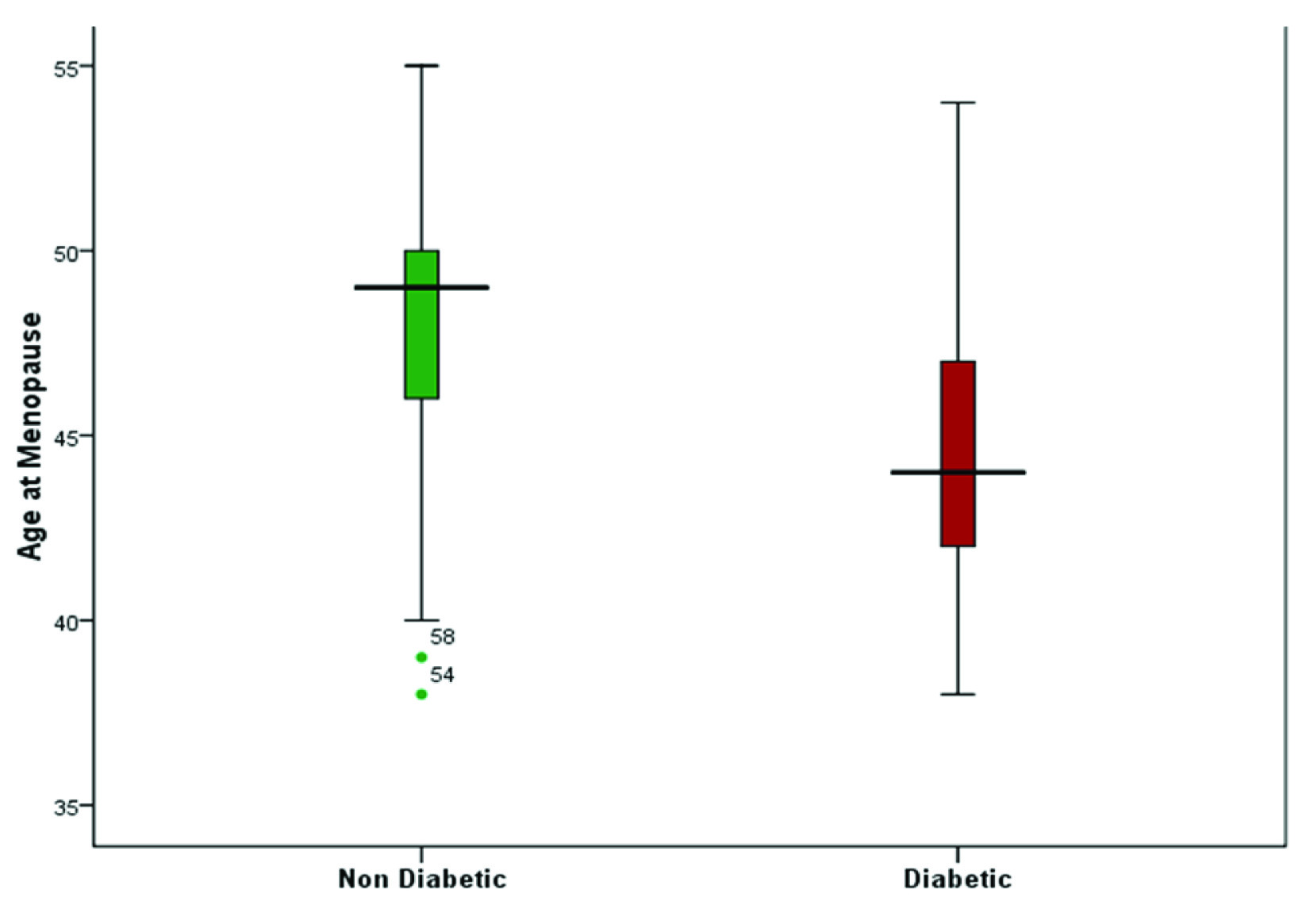
The complications of diabetes: [Table/Fig-5] Out of the 300 Diabetic women, 75% suffered from the complications of Diabetes. The commonest complication in our study group was retinopathy (40.66%), followed by diabetic nephropathy (27.33%), neuropathy (25.33%), coronary artery disease (17.33%), peripheral vascular disease (6%) and the least encountered complication was cerebrovascular disease (2%).
BMI and glycaemic control: [Table/Fig-6] Out of the 600 women in our study, 243 women had BMI>25. Among them, 144 women were diabetic and there was poor glycaemic control (HbA1C >7) in 120 women.
The complications of Diabetes in our study
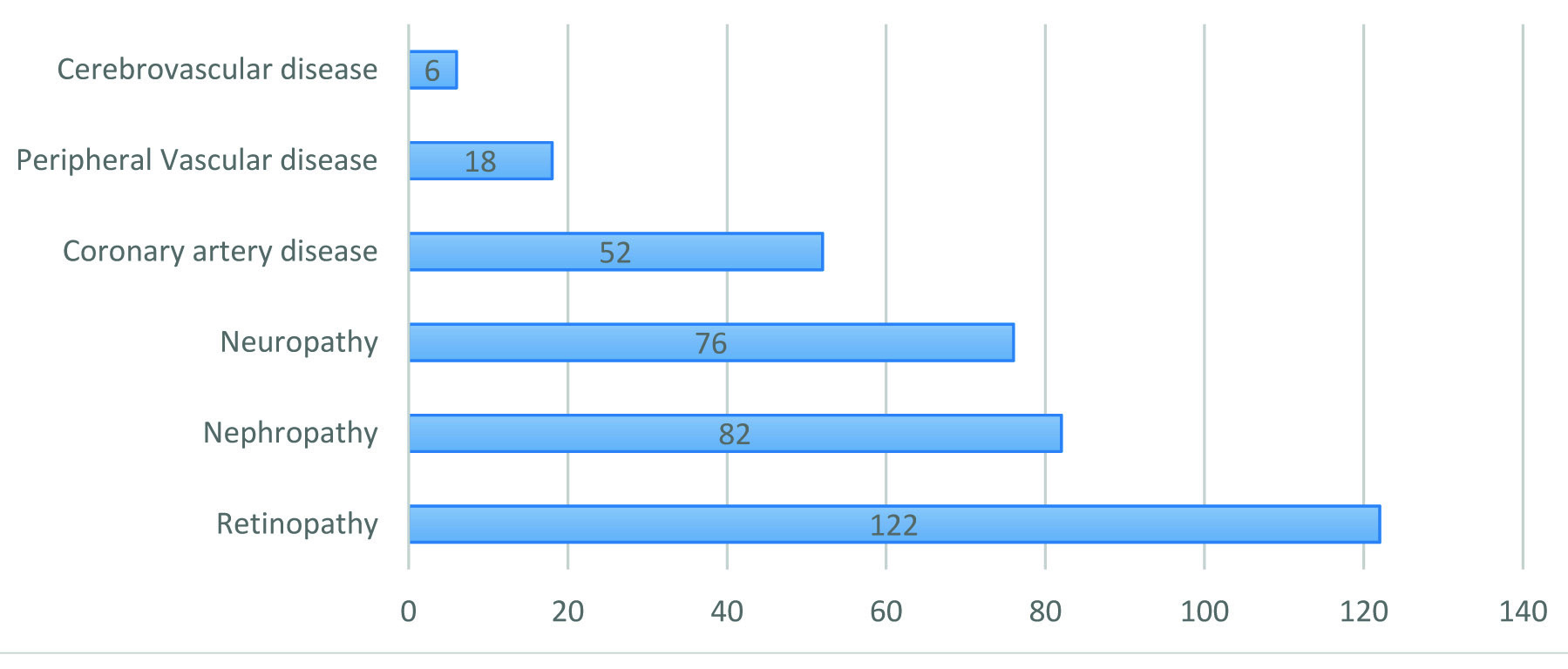
Relationship between BMI and glycaemic control r-value=0.06 p-value=0.33
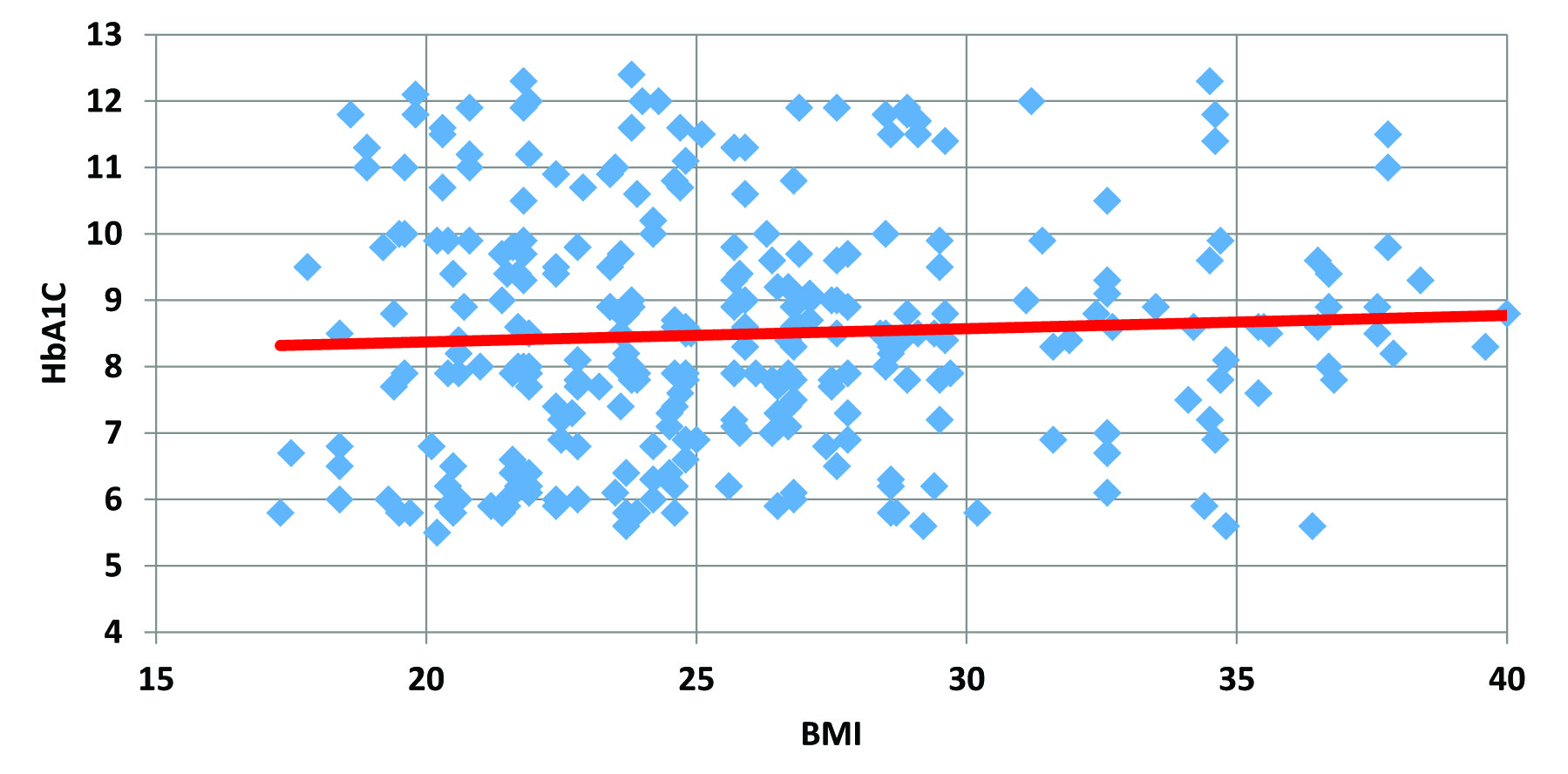
Discussion
Present study indicated that there is significant difference in age of menopause between the diabetic and non diabetic women (p-value <0.01) [Table/Fig-3,4]. Timing of menopause is an important determinant of future disease risk. An early age at menopause is associated with an increased risk of cardiovascular disease and osteoporosis in women [8,9]. Average age of menopause in Diabetic women is 4 years lesser than the normal population. An early menopause was attained by about 50% of the diabetics, whereas only 17% of the non-diabetic women attained such an early menopause. There are no previous studies on the Indian population but present study findings are similar to a latin American study which claims that diabetes can triple the risk of menopause [10]. Another SWAN (Study of women’s health across the nation) study done in USA showed that the average age of menopause was 6 years earlier in the Type 1 Diabetic women [11]. Present study, in contrast included women only with Type 2 Diabetes, so this might explain the difference that exists with the SWAN results. Some studies revealed lower levels of sex hormone binding globulin, estradiol, hypothalamic-pituitary hypofunction and hyperandrogenism in women with type-2 diabetes mellitus [12,13]. This could probably explain the results in the present study. Diabetic women are already at a high risk for premature morbidity and mortality from cardiovascular, cerebrovascular and peripheral vascular diseases. This earlier transition of menopause increases their risk.
The present study revealed no significant difference between BMI and poor glycaemic control (p=0.33) [Table/Fig-6]. It is similar to a study done in Karnataka, India in 2013 where they found no statistically significant relation between higher BMI and poor glycaemic control [14]. But in an International study, ‘Lifestyle factors associated with glycaemic control and BMI in older adults with diabetes’, it was found that a reduction in BMI resulted in a better glycaemic control [15].
The present study also showed an increase in BMI among the women with increase in the duration of DM (p-value=<0.01) [Table/Fig-7]. Menopause is associated with changes in body composition, such as increased total body fat or abdominal fat and a decrease in the lean body mass, which in turn are linked to impairments in glucose metabolism and insulin sensitivity [16]. The occurrence of dysglycemia may be a direct result of the ovarian failure, or alternatively an indirect result of the metabolic consequences of central fat redistribution with estrogen deficiency [17].
Relationship between duration of DM and BMI r-valu=0.17 p-value=<0.01
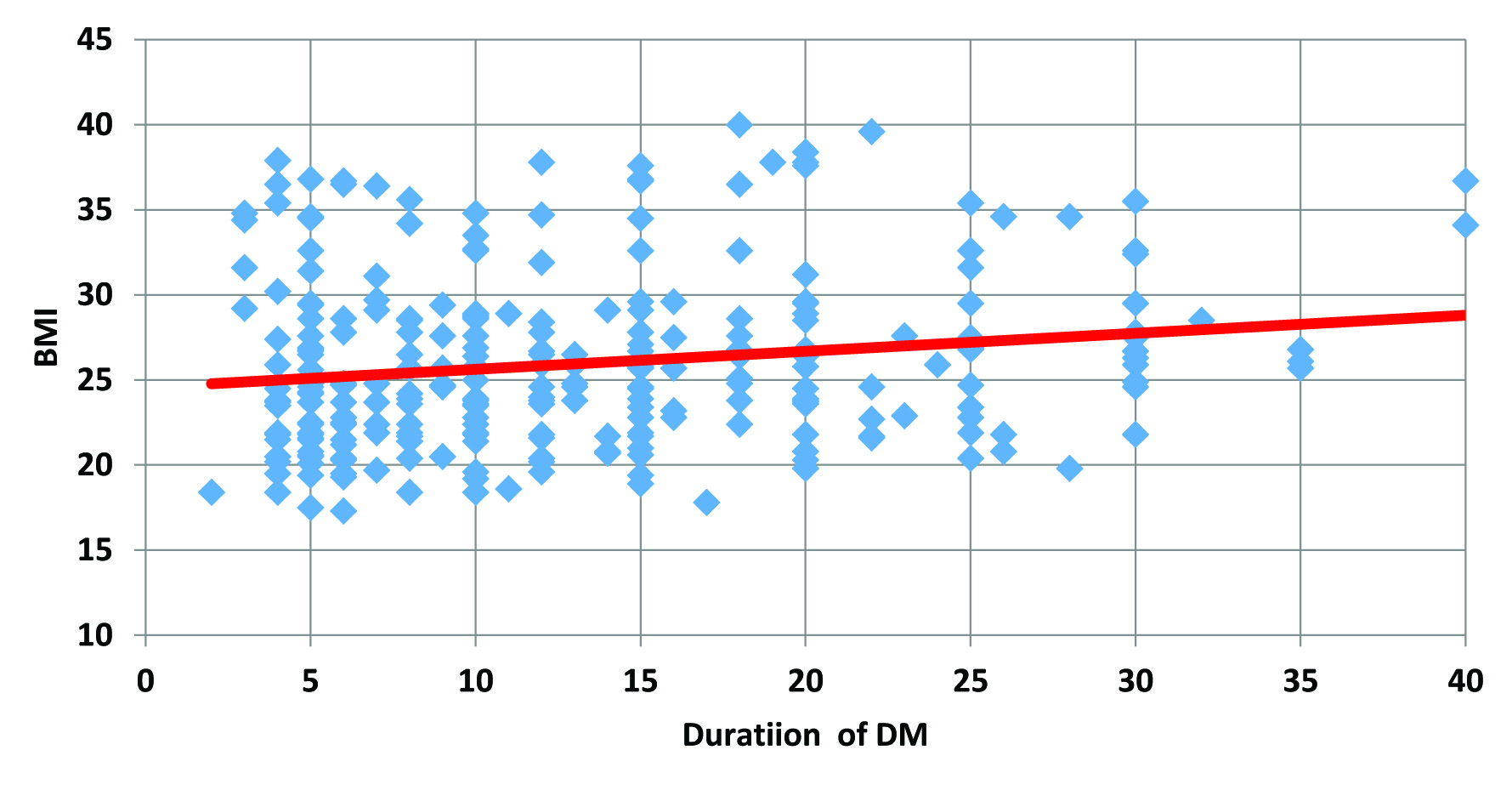
Relationship between HbA1C and duration of Diabetes r-value=0.36 p-value=<0.01
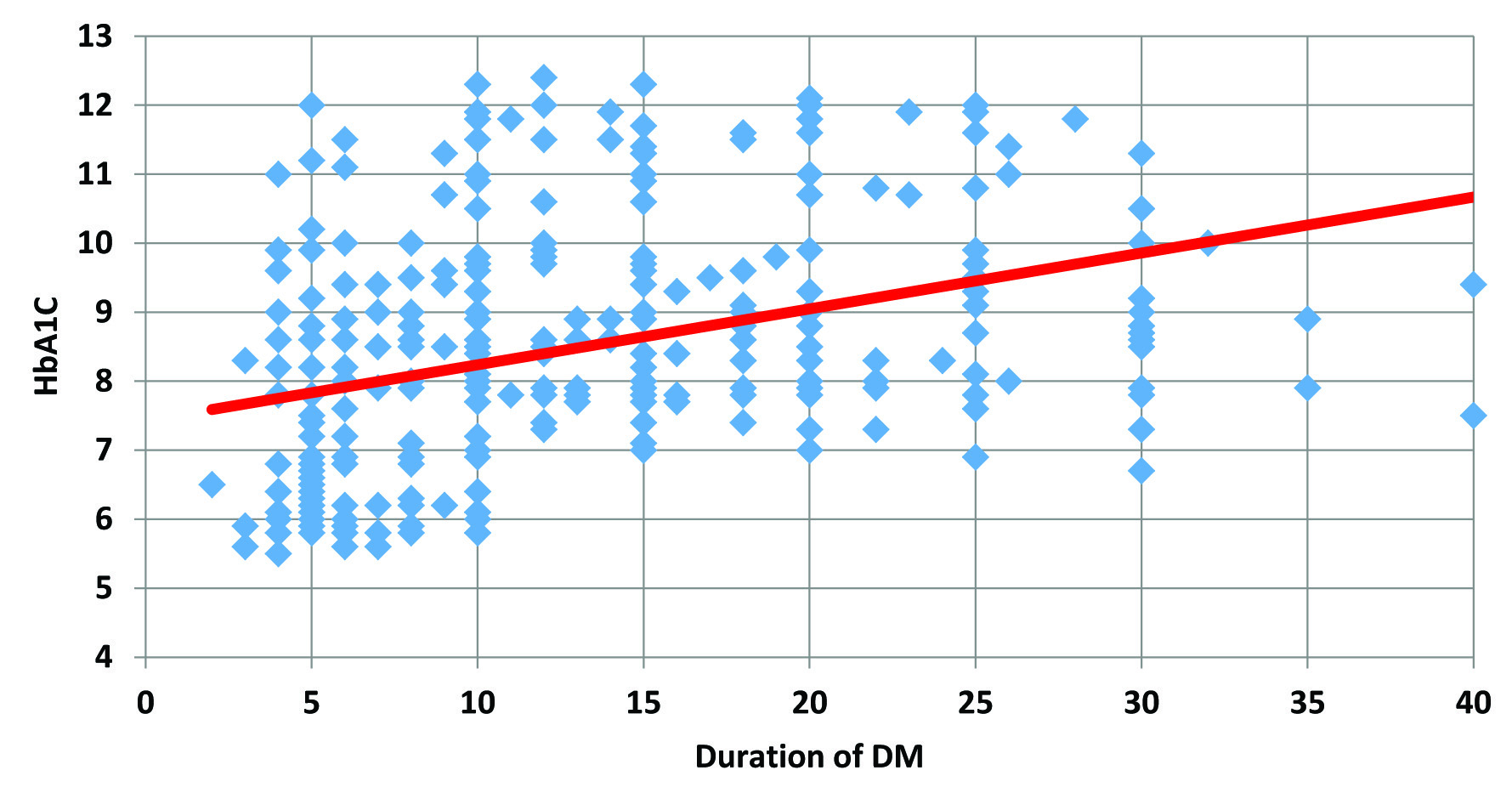
The biochemical studies also revealed that with the increase in the duration of diabetes, the HbA1c values showed a significant increase (p-value <0.01) [Table/Fig-8]. It was similar to the study done by the same author where longer duration of diabetes was associated significantly with a poor glycaemic control [18]. It is possibly because of progressive impairment of insulin secretion with time because of Beta cell failure, which makes the response to diet alone or oral agents unlikely and also the insulin resistance increases with duration of diabetes [19].
Majority of the diabetic women (72%) in our study suffered from microvascular and microvascular complications probably due to their long duration of diabetes. The most common complication observed in our study was diabetic retinopathy followed by nephropathy and neuropathy [Table/Fig-5]. CURES Eye study is the largest population based data on the prevalence of diabetic retinopathy done in India and this study showed that the overall prevalence was 17.6 % [20].
Limitations
The drawbacks in the present study were that the assessment of age at menopause was based on self report, which is prone to recall bias, particularly in older women. From our cross-sectional study we could not deduce, if proper glycaemic control would delay the onset of menopause among the diabetic women as long term studies would be required for that.
Conclusion
The present study confirms that Type 2 Diabetes significantly increases the risk of early menopause. A women’s natural supply of estrogen runs out much earlier than would normally, in diabetes, raising the risk of cardiovascular and bone disease in later life. So premature ovarian sufficiency does impair health and life expectancy if poorly managed. So our study reinforces the importance of early diagnosis and treatment of diabetes for a long term well being of a woman.